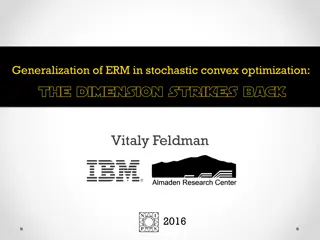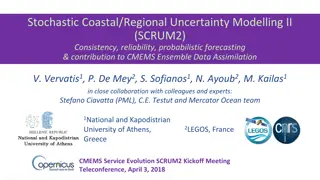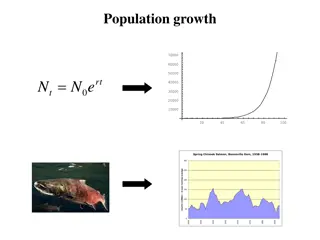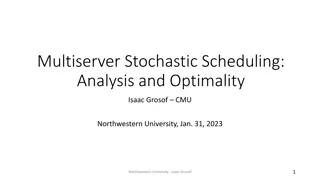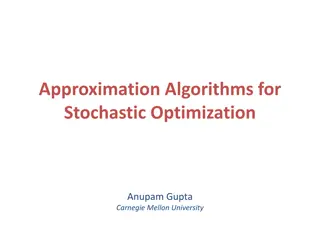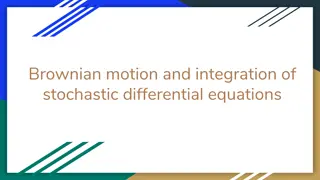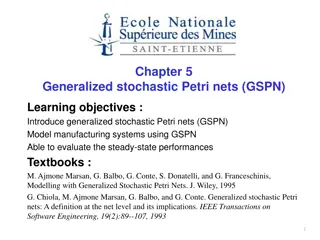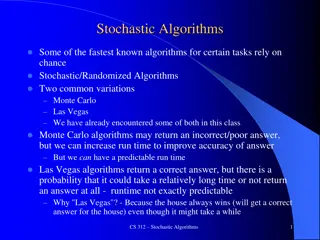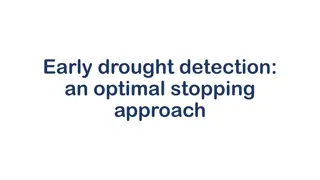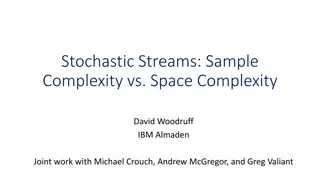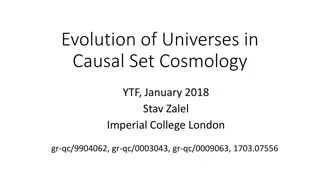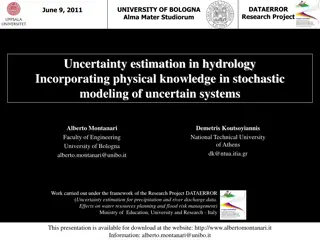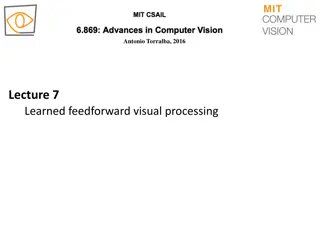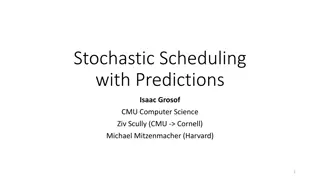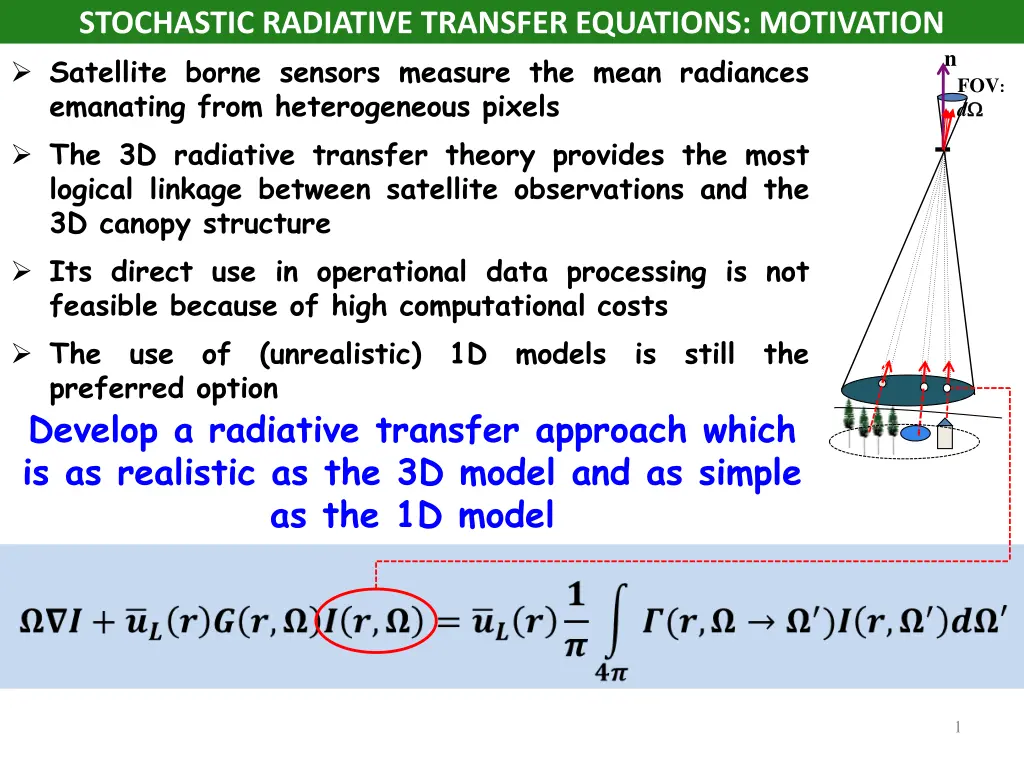
Stochastic Radiative Transfer Equations
Explore the development of a radiative transfer approach that bridges the gap between 1D and 3D models in canopy structure analysis. Learn about stochastic methods for accurate characterization of 3D vegetation canopies and radiation fields, providing insights into complex environmental processes.
Download Presentation

Please find below an Image/Link to download the presentation.
The content on the website is provided AS IS for your information and personal use only. It may not be sold, licensed, or shared on other websites without obtaining consent from the author. If you encounter any issues during the download, it is possible that the publisher has removed the file from their server.
You are allowed to download the files provided on this website for personal or commercial use, subject to the condition that they are used lawfully. All files are the property of their respective owners.
The content on the website is provided AS IS for your information and personal use only. It may not be sold, licensed, or shared on other websites without obtaining consent from the author.
E N D
Presentation Transcript
STOCHASTIC RADIATIVE TRANSFER EQUATIONS: MOTIVATION Satellite borne sensors measure the mean radiances emanating from heterogeneous pixels The 3D radiative transfer theory provides the most logical linkage between satellite observations and the 3D canopy structure Its direct use in operational data processing is not feasible because of high computational costs The use of (unrealistic) 1D models is still the preferred option Develop a radiative transfer approach which is as realistic as the 3D model and as simple as the 1D model n FOV: d 1
MEAN RADIANCE OF CANOPY REFLECTED RADIATION 1D APPROACH First average the extinction coefficient and scattering phase function and then solve the 1D RT equation with the characteristics average 2
MEAN RADIANCE OF CANOPY REFLECTED RADIATION 1D APPROACH First average the extinction coefficient and scattering phase function and then solve the 1D RT equation with the characteristics average 3D APPROACH First solve the 3D RT equation and then average its solution STOCHASTIC APPROACH aims to derive and solve a closed system of equations whose solutions are mean characteristics of the 3D field 3
STOCHASTIC RADIATIVE TRANSFER EQUATIONS Accurate specification of characteristics of 3D vegetation canopy and the corresponding characteristics of the 3D radiation field is needed relationships between statistical Problem: Stochastic view of the landscape, its structure and radiative transfer At given spatial location, the vegetation canopy should be treated as a realization of a stochastic process of space Canopy radiative response, too, is a realization of 3D radiation field Stationary Poisson Point Process as a powerful means to simulate 3D canopy structure Stochastic model of 3D canopy characteristics. Parameterization of 3D canopy structure in terms of variables that radiative transfer equation admits Mean characteristics of 3D radiation field Stochastic RTE provides accurate relationships between mean characteristics of the 3D canopy structure and 3D radiation field Examples structure and its mean 4
MEAN CHARACTERISTICS OF THE 3D CANOPY STRUCTURE AND 3D RADIATION FIELD Problem: Accurate specification of characteristics of 3D vegetation canopy and the corresponding characteristics of the 3D radiation field is needed relationships between statistical 1. Generate from the presumed known statistics of the vegetation canopy a certain realization of the 3D vegetation in a satellite pixel 2. For this realization, the 3D canopy radiation field is evaluated, either using a 3D canopy radiation model or by a Monte Carlo procedure 3. Repeat this process for all possible statistical realization of the canopy 4. Average the radiation fields to obtain the ensemble average radiance and higher statistical moments Steps 2-3 Step 1 Step 4 3D canopy structure as an indicator function (r) (r) is a stochastic function of space Derive equations for statistical characteristics of the 3D radiation field as a function of statistical characteristics of 3D canopy structure 5
POISSON DISTRIBUTION AND POISSON STOCHASTIC PROCESS Poisson distribution: void probability: the probability of there being no points of the process in a given area S, i.e. Stationary Poisson Point Process (SPPP): Intensity or density of the SPPP: (in #/mk, k=1,2 3) The number of points in a set S is a Poisson random variable: P(m), E(m)= S The void probability, S, of a point process is the probability of there being no point of the process in a given set S, i.e., S=exp(- S) 6
CANOPY STRUCTURE AS A STOCHASTIC PROCESS Underlying assumption distribution of tree stems is a Stationary Poisson Point Process The number of trees, m, in a given pixel S is a Poisson random variable: P(m), E(m)= S Intensity or density: (in #/m2) void probability: the probability of there being no points of the process in a given area S, i.e. 7
STRUCTURE AND RADIATION AS A STOCHASTIC PROCESS Poisson distribution: void probability: the probability of there being no points of the process in a given area S, i.e. Poisson germ-grain stochastic model of forest with cylindrical in shape trees 1.Select a random number m of trees within a pixel area S 8
STRUCTURE AND RADIATION AS A STOCHASTIC PROCESS Poisson distribution: void probability: the probability of there being no points of the process in a given area S, i.e. Poisson germ-grain stochastic model of forest with cylindrical in shape trees 1.Select a random number m of trees within a pixel area S using the Poisson distribution 2.Generate random locations of m stems using a uniform distribution function 9
STRUCTURE AND RADIATION AS A STOCHASTIC PROCESS Poisson distribution: void probability: the probability of there being no points of the process in a given area S, i.e. Poisson germ-grain stochastic model of forest with cylindrical in shape trees 1.Select a random number m of trees within a pixel area S using the Poisson distribution 2.Generate random locations of m stems using a uniform distribution function 3.Place a geometrical figure on each of these points 1(r) RealStructure1 10
STRUCTURE AND RADIATION AS A STOCHASTIC PROCESS Poisson distribution: void probability: the probability of there being no points of the process in a given area S, i.e. Poisson germ-grain stochastic model of forest with cylindrical in shape trees 1.Select a random number m of trees within a pixel area S using the Poisson distribution 2.Generate random locations of m stems using a uniform distribution function 3.Place a geometrical figure on each of these points 4.Solve the 3D radiative transfer equation using simulated canopy structure as input Structure1, Radiation1 5.Go to step 1 1.Select a random number m of trees within a pixel area S using the Poisson distribution 2.Generate random locations of m stems using a uniform distribution function 3.Place a geometrical figure on each of these points 4.Solve the 3D radiative transfer equation using simulated canopy structure as input 1(r) 11
STRUCTURE AND RADIATION AS A STOCHASTIC PROCESS Poisson distribution: void probability: the probability of there being no points of the process in a given area S, i.e. Poisson germ-grain stochastic model of forest with cylindrical in shape trees 1. Select a random number m of trees within a pixel area S using the Poisson distribution 2. Generate random locations of m stems using a uniform distribution function 3. Place a geometrical figure on each of these points 4. Solve the 3D radiative transfer equation using simulated canopy structure as input 5.Repeat this process N times 1(r) 2(r) Realization #1: m=3 Structure2; Radiation2; Realization #1: m=3 Structure1; Radiation1; 12
STRUCTURE AND RADIATION AS A STOCHASTIC PROCESS Poisson distribution: void probability: the probability of there being no points of the process in a given area S, i.e. Poisson germ-grain stochastic model of forest with cylindrical in shape trees 1(r) N(r) 2(r) Mean Structure Realization #1: m=3 Structure2; Radiation2; Realization #1: m=3 StructureN; RadiationN; Realization #1: m=3 Structure1; Radiation1; 13
STRUCTURE AND RADIATION AS A STOCHASTIC PROCESS Poisson distribution: Mean Intensity Mean Radiation field void probability: the probability of there being no points of the process in a given area S, i.e. Huang et al., 2008. "Stochastic transport theory for investigating the three-dimensional canopy structure from space measurements." Remote Sensing of Environment 112 (1):35-50. doi: 10.1016/j.rse.2006.05.026. Yang et al., 2017. "Estimation of leaf area index and its sunlit portion from DSCOVR EPIC data: Theoretical basis." Remote Sensing of Environment 198:69-84. doi: 10.1016/j.rse.2017.05.033. Poisson germ-grain stochastic model of forest with cylindrical in shape trees 1(r) N(r) 2(r) Realization #1: m=3 Structure2; Radiation2; Realization #1: m=3 StructureN; RadiationN; Realization #1: m=3 Structure1; Radiation1; 14 Mean Structure
STOCHASTIC RADIATIVE TRANSFER EQUATIONS Statistical characteristics of the 3D structure Ground cover at z: p(z) probability of finding a foliated point at depth z Pair correlation function: q(z, , ) probability of finding simultaneously foliated points on horizontal planes z and along a given direction Conditional pair-correlation function: K(z, , )=q(z, , )/p(z) Statistical characteristics of 3D radiation field Mean radiance Mean radiance over a horizontal plane at z Second moment Mean radiance incident on the leaf surface 15
CONDITIONAL PAIR-CORRELATION FUNCTION the conditional probability of finding vegetation at depth along direction , given that there is a vegetated point at z Monte Carlo generated pair correlation function (K) for cylindrical trees Clumping: detecting a leaf makes it more likely that another leaf will be detected nearby K=const, 1D canopy Finest scale: variability at finest scale Ground cover: vegetation fraction Crown size: horizontal dimension of tree crowns 16 16
CONDITIONAL PAIR-CORRELATION FUNCTION Pair correlation function can describe the hierarchical clumping structure of natural vegetation canopy. Ground cover is 0.21 for all cases.
CONDITIONAL PAIR-CORRELATION FUNCTION The pair correlation function provides a measure of the 3D canopy structure over a wide range of scales The SRTE naturally admits this measure. Therefore, the pair correlation function introduces 3D sensitivity to the mean radiation field
HORIZONTAL HETEROGENEITY Lowers canopy reflectance and absorptance Enhances canopy transmittance 1D Poisson 19
GROUPING OF CROWNS Crown grouping Crown grouping usually enhances transmittance and lowers absorptance. 1D Poisson 20
CROWN SHAPE The conical crown model predicts highest transmittance absorptance, because it has the highest degree of clumping of the 3 cases. and lowest 21
SUMMARY The spatial correlation between foliage is responsible for the effects of 3D canopy structure on the radiation field. With realistic models of the pair correlation function, SRTE can reproduce the 3D effects reported in literature. The SRTE provides a powerful tool to develop operational algorithms for monitoring canopy structure from space, and to describe the land surface radiation budget. its solution is exactly what satellite sensors measure; it is as realistic as 3D models; it is as simple as 1D models. Huang et al., 2008. "Stochastic transport theory for investigating the three-dimensional canopy structure from space measurements." Remote Sensing of Environment 112 (1):35-50. doi: 10.1016/j.rse.2006.05.026. 22



